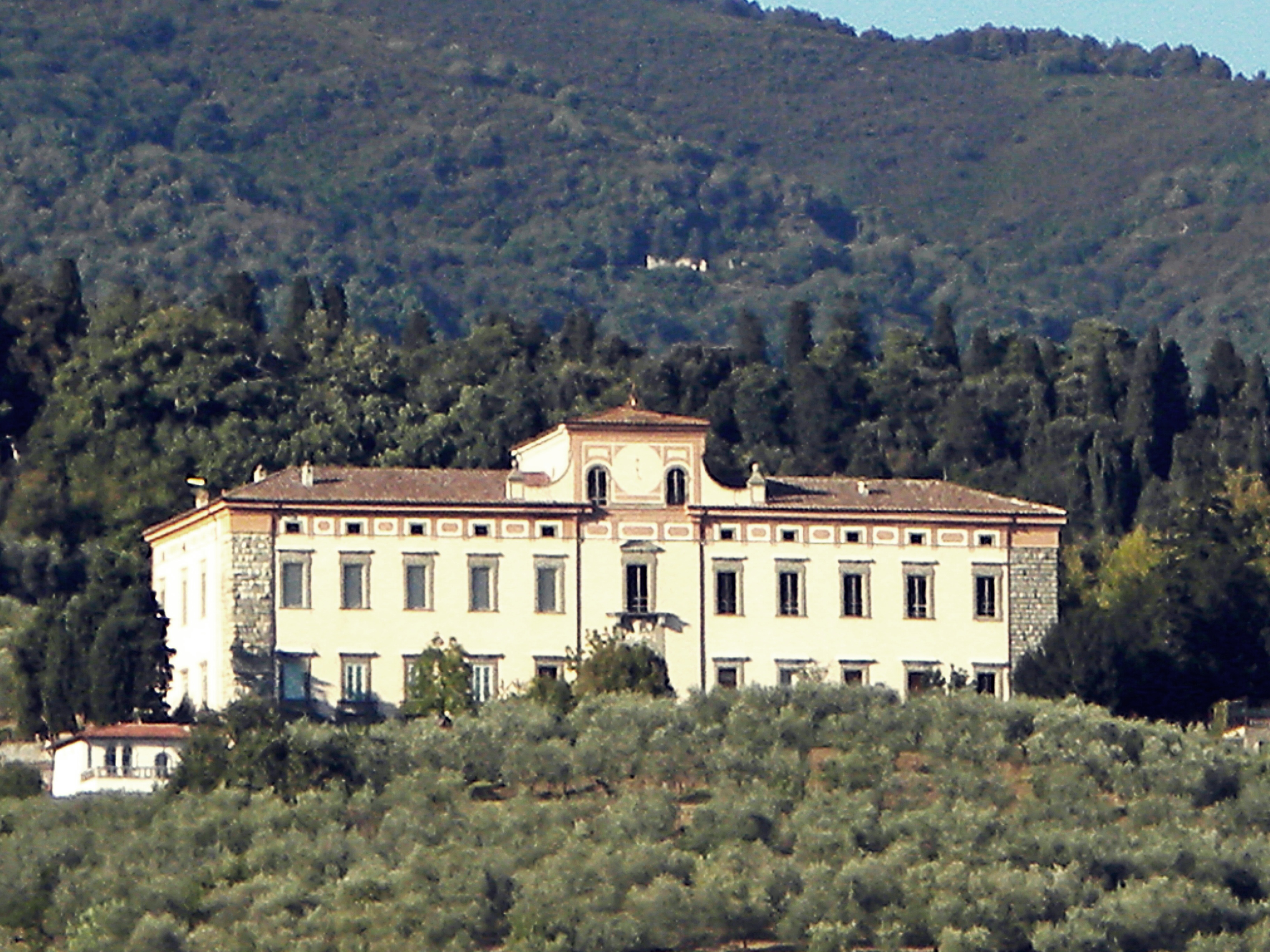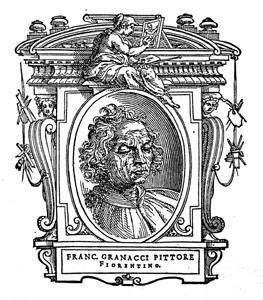|
San Giovanni Battista Decollato, Montemurlo
San Giovanni Battista Decollato (''St John the Baptist Beheaded'') is a renaissance-style, Roman Catholic rural parish church located in the Borgo della Rocca of town of Montemurlo, province of Prato, region of Tuscany, Italy. History The ''pieve'' church has an unfinished brick facade with a 15th-century portico. A single nave with lateral altars is now lit by 18th-century windows. The church houses an altarpiece depicting the ''Madonna and Child with Saints'' (1522) by Francesco Granacci; another ''Madonna and Saints'' (1590) by Giovanni Stradano; a ''Virgin of the Rosary and Saints'' (1609) by Matteo Rosselli Matteo Rosselli (10 August 1578 – 18 January 1650) was an Italian painter of the late Florentine Counter- Mannerism and early Baroque. He is best known however for his highly populated grand-manner historical paintings. Biography He first app ..., and a canvas by Giacinto Fabbroni. The presbytery has a venerated silver crucifix from the 14th century. The ''Story of ... [...More Info...] [...Related Items...] OR: [Wikipedia] [Google] [Baidu] |
Renaissance Architecture
Renaissance architecture is the European architecture of the period between the early 15th and early 16th centuries in different regions, demonstrating a conscious revival and development of certain elements of Ancient Greece, ancient Greek and Ancient Rome, Roman thought and material culture. Stylistically, Renaissance architecture followed Gothic architecture and was succeeded by Baroque architecture. Developed first in Florence, with Filippo Brunelleschi as one of its innovators, the Renaissance style quickly spread to other Italian cities. The style was carried to Spain, France, Germany, England, Russia and other parts of Europe at different dates and with varying degrees of impact. Renaissance style places emphasis on symmetry, proportion (architecture), proportion, geometry and the regularity of parts, as demonstrated in the architecture of classical antiquity and in particular ancient Roman architecture, of which many examples remained. Orderly arrangements of columns, pi ... [...More Info...] [...Related Items...] OR: [Wikipedia] [Google] [Baidu] |
Roman Catholic
Roman or Romans most often refers to: *Rome, the capital city of Italy *Ancient Rome, Roman civilization from 8th century BC to 5th century AD *Roman people, the people of ancient Rome *'' Epistle to the Romans'', shortened to ''Romans'', a letter in the New Testament of the Christian Bible Roman or Romans may also refer to: Arts and entertainment Music * Romans (band), a Japanese pop group * ''Roman'' (album), by Sound Horizon, 2006 * ''Roman'' (EP), by Teen Top, 2011 *" Roman (My Dear Boy)", a 2004 single by Morning Musume Film and television * Film Roman, an American animation studio * ''Roman'' (film), a 2006 American suspense-horror film * ''Romans'' (2013 film), an Indian Malayalam comedy film * ''Romans'' (2017 film), a British drama film * ''The Romans'' (''Doctor Who''), a serial in British TV series People *Roman (given name), a given name, including a list of people and fictional characters *Roman (surname), including a list of people named Roman or Romans *Ῥωμ� ... [...More Info...] [...Related Items...] OR: [Wikipedia] [Google] [Baidu] |
Montemurlo
Montemurlo is a ''comune'' (municipality) in the Province of Prato in the Italian region Tuscany, located about northwest of Florence and about northwest of Prato. Montemurlo borders the following municipalities: Agliana, Cantagallo, Montale, Prato, Vaiano. Main sights Churches *Chapel at Javello farm *Chapel at the fortress in Montemurlo *Chapel at Villa del Barone in Bagnolo di Sopra *Chapel at Villa Giamari in Fornacelle *Parish Church of San Giovanni Battista Decollato San Giovanni Decollato (''the Beheaded John the Baptist'') is a Roman Catholic church in Rome, sited on ''via di San Giovanni Decollato'' in the Ripa rione, a narrow road named after the church. Its construction took most of the 16th century. I ... at Montemurlo castle *Sacred Heart of Jesus in Montemurlo *San Pietro in Albiano *Santa Maria Maddalena de' Pazzi in Bagnolo *Holy Mary Mother of the Church in Oste *Holy Mary Mother of God in Fornacelle Villas *Old Village Riva di Bagnolo in Bagnolo di S ... [...More Info...] [...Related Items...] OR: [Wikipedia] [Google] [Baidu] |
Tuscany
Tuscany ( ; it, Toscana ) is a Regions of Italy, region in central Italy with an area of about and a population of about 3.8 million inhabitants. The regional capital is Florence (''Firenze''). Tuscany is known for its landscapes, history, artistic legacy, and its influence on high culture. It is regarded as the birthplace of the Italian Renaissance and of the foundations of the Italian language. The prestige established by the Tuscan dialect's use in literature by Dante Alighieri, Petrarch, Giovanni Boccaccio, Niccolò Machiavelli and Francesco Guicciardini led to its subsequent elaboration as the language of culture throughout Italy. It has been home to many figures influential in the history of art and science, and contains well-known museums such as the Uffizi and the Palazzo Pitti. Tuscany is also known for its wines, including Chianti, Vino Nobile di Montepulciano, Morellino di Scansano, Brunello di Montalcino and white Vernaccia di San Gimignano. Having a strong linguisti ... [...More Info...] [...Related Items...] OR: [Wikipedia] [Google] [Baidu] |
Francesco Granacci
Francesco Granacci (1469 – 30 November 1543) was an Italian Renaissance painter active primarily in his native Florence. Though little-known today, he was regarded in his time and is featured in Giorgio Vasari's ''Lives of the Artists''. Granacci was born in 1469 in Villamagna, and was trained in Florence in the workshop of Domenico Ghirlandaio, where he became lifelong friends with Michelangelo. The two frequented Lorenzo de' Medici's famous sculpture garden near the convent of San Marco. His earliest works, such as the ''Madonna and Child with Saints Michael and John the Baptist'' (Staatliche Museen, Berlin), ''Adoration of the Child'' (Honolulu Museum of Art) and his panel from the four histories of ''Saint John the Baptist'' (Metropolitan Museum of Art, New York) show the strong influence of Ghirlandaio as well as Filippino Lippi, who might have been Granacci's first master. According to Vasari, when Granacci was still a youth he modeled for the nude figure in Filippin ... [...More Info...] [...Related Items...] OR: [Wikipedia] [Google] [Baidu] |
Giovanni Stradano
Stradanus, Johannes Stradanus, Jan van der Straet or Giovanni StradanoMore name variations: Johannes Stradanus, Giovanni della Strada, Johannes della Strada, Giovanni Stradano, Johannes Stradano, Giovanni Stradanus, Johannes Stradanus, Jan van Straeten, Jan van Straten Jan van der Straet at the De liggeren en andere historische archieven der Antwerpsche sint Lucasgilde van 1453–1615 edited and published by ... [...More Info...] [...Related Items...] OR: [Wikipedia] [Google] [Baidu] |
Matteo Rosselli
Matteo Rosselli (10 August 1578 – 18 January 1650) was an Italian painter of the late Florentine Counter- Mannerism and early Baroque. He is best known however for his highly populated grand-manner historical paintings. Biography He first apprenticed with Gregorio Pagani. On 26 February 1599, he was inducted to the Accademia del Disegno, and in 1605 traveled to Rome to work with Domenico Passignano for six months. He completed some frescoes on ''The Legend of the Origin of the Servite Order'' (1614–1618) in the Palazzo Pitti and in the Cloister of the Basilica della Santissima Annunziata; a ''Madonna and child with St Francis'' altarpiece for the Church of Santa Maria Maggiore in Florence; and an ''Adoration of the Magi'' (1607) for the Church of Sant'Andrea in Montevarchi. He painted a ''Crucifixion'' (1613) now in the parish church at Scarperia. He painted a ''Last Supper'' (1614) now in Conservatorio di San Pier Martire. Upon the French monarch's death, he was commiss ... [...More Info...] [...Related Items...] OR: [Wikipedia] [Google] [Baidu] |
Giacinto Fabbroni
Giacinto Fabbroni (active mid-18th century) was an Italian painter, born in Prato, but mainly active in Impruneta and Florence Florence ( ; it, Firenze ) is a city in Central Italy and the capital city of the Tuscany region. It is the most populated city in Tuscany, with 383,083 inhabitants in 2016, and over 1,520,000 in its metropolitan area.Bilancio demografico an .... He painted an altarpiece of ''La Concezione'' for one of the chapels the church of San Gaetano in Florence. References 18th-century Italian painters Italian male painters Italian Baroque painters Year of death unknown Year of birth unknown 18th-century Italian male artists {{Italy-painter-18thC-stub ... [...More Info...] [...Related Items...] OR: [Wikipedia] [Google] [Baidu] |
Giovanni Da Prato
Giovanni may refer to: * Giovanni (name), an Italian male given name and surname * Giovanni (meteorology), a Web interface for users to analyze NASA's gridded data * ''Don Giovanni'', a 1787 opera by Wolfgang Amadeus Mozart, based on the legend of Don Juan * Giovanni (Pokémon), boss of Team Rocket in the fictional world of Pokémon * Giovanni (World of Darkness), a group of vampires in ''Vampire: The Masquerade/World of Darkness'' roleplay and video game * "Giovanni", a song by Band-Maid from the 2021 album '' Unseen World'' * '' Giovanni's Island'', a 2014 Japanese anime drama film * ''Giovanni's Room'', a 1956 novel by James Baldwin * Via Giovanni, places in Rome See also * * *Geovani *Giovanni Battista *San Giovanni (other) San Giovanni, the Italian form of "Saint John", is a name that may refer to dozens of saints. It may also refer to several places (most of them in Italy) and religious buildings: Places France *San-Giovanni-di-Moriani, a municipality of the Hau ... [...More Info...] [...Related Items...] OR: [Wikipedia] [Google] [Baidu] |
15th-century Roman Catholic Church Buildings In Italy
The 15th century was the century which spans the Julian dates from 1 January 1401 ( MCDI) to 31 December 1500 ( MD). In Europe, the 15th century includes parts of the Late Middle Ages, the Early Renaissance, and the early modern period. Many technological, social and cultural developments of the 15th century can in retrospect be seen as heralding the "European miracle" of the following centuries. The architectural perspective, and the modern fields which are known today as banking and accounting were founded in Italy. The Hundred Years' War ended with a decisive French victory over the English in the Battle of Castillon. Financial troubles in England following the conflict resulted in the Wars of the Roses, a series of dynastic wars for the throne of England. The conflicts ended with the defeat of Richard III by Henry VII at the Battle of Bosworth Field, establishing the Tudor dynasty in the later part of the century. Constantinople, known as the capital of the world an ... [...More Info...] [...Related Items...] OR: [Wikipedia] [Google] [Baidu] |
Renaissance Architecture In Tuscany
The Renaissance ( , ) , from , with the same meanings. is a period in European history marking the transition from the Middle Ages to modernity and covering the 15th and 16th centuries, characterized by an effort to revive and surpass ideas and achievements of classical antiquity. It occurred after the Crisis of the Late Middle Ages and was associated with great social change. In addition to the standard periodization, proponents of a "long Renaissance" may put its beginning in the 14th century and its end in the 17th century. The traditional view focuses more on the early modern aspects of the Renaissance and argues that it was a break from the past, but many historians today focus more on its medieval aspects and argue that it was an extension of the Middle Ages. However, the beginnings of the period – the early Renaissance of the 15th century and the Italian Proto-Renaissance from around 1250 or 1300 – overlap considerably with the Late Middle Ages, conventionally dat ... [...More Info...] [...Related Items...] OR: [Wikipedia] [Google] [Baidu] |





%2C_Matteo_Rosselli.jpg)

